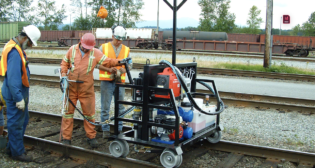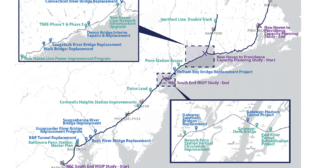
NYCT Canarsie Tunnels Repair Completed
Written by David Peter Alan, Contributing EditorNew York Gov. Andrew Cuomo predicted last year that the Canarsie Tunnels between Brooklyn and Fourteenth Street in Manhattan on New York City Transit’s L train line would be repaired without a major service disruption. He was correct. Cuomo announced on April 26 that the service reductions necessitated by the tunnel repair project were over, and that both tunnels would be open for service on April 27 under the New York MTA Essential Service Plan. His announcement came on the one-year anniversary of the beginning of reduced service.
Superstorm Sandy damaged the tunnels in late 2012. The original repair plan called for demolishing and rebuilding the bench walls and embedded cables. This would have required a total service shutdown on the portion of the L line in Manhattan and under the East River to Brooklyn for 18 months. All stations in Brooklyn except one would have still provided service, but there would have been no subway service in Manhattan on 14th Street for the first time in almost 95 years.
With neighborhood development and a spurt of ridership growth in recent years along the L, NYCT’s first line upgraded to CBTC (communications-based train control), Cuomo looked toward a less-disruptive alternative. He called on the deans and senior faculty of the Columbia and Cornell University engineering schools for a second opinion. They recommended abandoning the cables encased in the tunnel’s bench walls, hanging new cables on racks mounted to the tunnel wall, and covering them with FRP (fiber reinforced polymer, a state-of-the-art protective material. A local supplier, Snake Tray®, provided the cable racking system.
Cuomo’s official announcement touted that the MTA completed the project three months ahead of schedule and six months ahead of the original total-shutdown proposal, saving $100 million. The announcement also said that additional station, accessibility and capacity upgrades related to the tunnel project will be completed this fall.
A video of Cuomo’s announcement can be found at https://www.youtube.com/watch?v=ZTOfixtc21A&feature=youtu.be.
Cuomo defended his decision to approve the plan proposed by the Columbia and Cornell engineers, which generated intense criticism when announced. “The opposition to this new idea was an explosion,” he said. “[The critics said] I was a meddler; I didn’t have an engineering degree; they were outside experts, how dare you question the bureaucracy; the bureaucracy knows better. It was a thunderstorm of opposition, but we went ahead with it. The tunnel is now done better than before, with all these new techniques.”*
Cuomo’s release included links to an MTA video of a “virtual first ride” and a set of construction photos from the project.
The Columbia-Cornell plan reversed the total service disruption, but there were still some relatively minor service cuts. Service on the affected part of the line was reduced to running every 20 minutes on weekends and after 8:00 p.m. weeknights, while trains ran the full schedule at peak hours and during mid-day and early evenings on weekdays.
Before construction began, trains ran every 5 to 10 minutes for much of the service day, but the COVID-19 virus has caused some cuts. The MTA said that trains will run every 10 to 12 minutes on the line.
A variation of Canarsie Tunnels rehabilitation may be used on the North River Tunnels (Hudson Tunnels) between New Jersey and New York Penn Station on Amtrak’s Northeast Corridor. Part of the proposed Gateway Program includes two new tracks in new tunneling under the Hudson River, but Gateway’s proponents have consistently pushed for a project schedule that called for completing the new tunnel before the existing ones would be repaired. That would take at least ten years, although Gateway Vice Chair and Amtrak Board Chair Anthony R. Coscia expressed doubt that the existing tunnels were certain to last even five more years, while continuing to alarm the public and disparage the method used to rehabilitate the Canarsie Tunnels.
U.S. Transportation Secretary Elaine Chao later called for the method used to repair the Canarsie Tunnels to be used on the Hudson Tunnels. “I’m pleased to report that the [USDOT] is working closely with Amtrak to advance rehabilitation work on the existing Hudson Tunnels,” she said. “Given the time, the cost and the complexity of building entirely new tunnels, the Department is working with Amtrak to design and validate a faster and more cost-effective method to improve safety and functionality as the first order of business. So, beginning rehab work in the near term is the right move, not waiting years for the construction of new tunnels beforehand.”
Author’s Note, May 4, 2020: The Daring and Resourceful Masked Riders of the Trains did not show up in force to ride the “new” L-Train under Fourteenth Street in Manhattan and into Brooklyn, but the trains were there, and they exceeded MTA expectations. Instead of running every ten minutes, they ran every five. This writer checked out the line during the first weekend of full service, on Sunday, May 3, at noon. During the busiest part of the ride, east of Union Square and heading toward Brooklyn, there were ten riders in the car at the center of the train. The ride was fast and smooth, and it was possible to see the new cables from the train window during the portion of the journey under the East River. In announcing the completion of the Canarsie Tunnels project on April 26, Gov. Cuomo defended his unorthodox decision to follow the advice of members of the Columbia and Cornell engineering faculties and repair the tunnels, while averting a total shutdown for 15 months or longer. He told the City and State: “We know that we can. We showed that we can.” Now he proved it. The riders have not come back yet, because almost everything else is shut down due to the COVID-19 virus. But when the riders return to the subways, the L-Train will be ready for them. – David Peter Alan
*Editor’s Note: This remains to be seen. Among Cuomo’s so-called “bureaucrats” are transit professionals with years of experience, like former NYCT Presidents Carmine Bianco, who wrote this op-ed piece for The New York Times in January 2019. , and Andy Byford, who resigned his post earlier this year over what can best be described as “irreconcilable differences.” Cuomo’s leadership, clarity, compassion, humanity, humility and well-informed, intelligent common-sense approach during New York City’s ongoing horrible, tragic experience with the COVID-19 pandemic are exemplary—Presidential, if you think about it—but this does not negate the fact that he is not a railway expert. The Canarsie Tunnel repair, by some accounts, could last up to 40 years, but the original plan, albeit more costly and service-disruptive, was designed to last 100 years, according to many railway engineering experts. – William C. Vantuono



